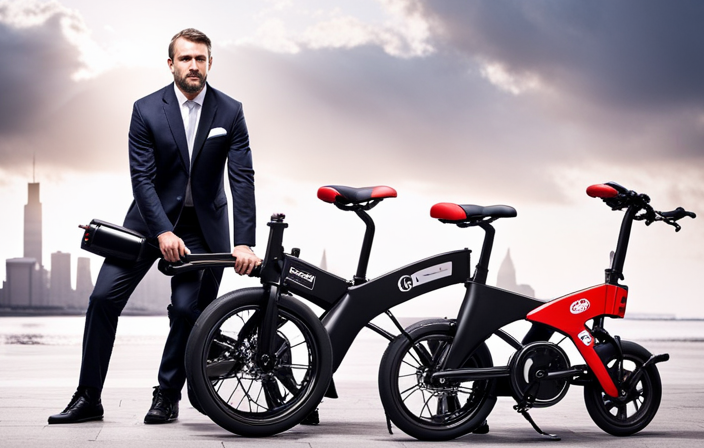As a passionate cyclist, I have always been interested in the capabilities of electric bikes. The idea of effortlessly covering long distances without exerting much effort is appealing, but I wonder how far an electric bike can truly go on a single charge.
In this article, we’ll delve into the factors that influence an electric bike’s range, explore different types of electric bikes and their respective ranges, and provide tips on maximizing your electric bike’s range.
So, let’s strap on our helmets and embark on a data-driven journey to find out just how far these electric steeds can take us!
Key Takeaways
- Maintaining tire pressure and minimizing weight and resistance can optimize electric bike performance and extend the range.
- The battery capacity determines the range of an electric bike, with larger batteries allowing for longer rides.
- There are various charging options available for electric bikes, including traditional plug-in chargers, solar power charging, and regenerative braking charging.
- Range anxiety, the concern of running out of battery power, can be overcome through route planning, knowledge of charging station locations, and advancements in battery technology and charging infrastructure.
Understanding Electric Bike Range
Electric bikes typically have a range of around 20-50 miles per charge. However, this range can vary depending on several factors.
To calculate the range of an electric bike, you need to consider factors such as battery capacity, motor efficiency, terrain, and rider weight. The battery capacity determines how much energy the bike can store, while motor efficiency determines how efficiently that energy is converted into movement.
Terrain plays a role because riding uphill consumes more energy than riding on flat ground. Additionally, the weight of the rider affects the bike’s efficiency, as a heavier rider requires more power to move the bike.
By understanding these factors and taking steps to increase efficiency, such as maintaining proper tire pressure and avoiding excessive acceleration, you can maximize the range of your electric bike.
Factors that influence an electric bike’s range go beyond just battery capacity and will be discussed in the next section.
Factors That Influence an Electric Bike’s Range
To maximize your electric bike’s range, consider factors such as terrain, rider weight, and weather conditions. These factors can significantly impact the distance you can travel on a single charge. Here are some key considerations:
- Terrain: Uphill climbs and rough terrain use more battery power, reducing your range.
- Rider weight: Heavier riders require more power to propel the bike, decreasing the range.
- Weather conditions: Extreme temperatures, strong headwinds, and rain can affect battery performance and decrease range.
- Battery type: Different types of batteries, such as lithium-ion or lead-acid, have varying energy densities and can impact the range.
- Battery age and condition: Over time, battery capacity decreases, reducing the range.
Understanding these factors will help you make informed decisions about your electric bike’s range and plan your rides accordingly.
Now, let’s explore how to calculate the electric bike range without step-by-step instructions.
How to Calculate Electric Bike Range
Calculating your e-bike’s range involves considering factors like battery capacity, motor power, and average speed.
To estimate how far your electric bike can go on a single charge, you need to calculate the battery life. This can be done by dividing the battery’s capacity (measured in watt-hours) by the power consumption of the motor (measured in watts). For example, if your battery has a capacity of 500 watt-hours and your motor consumes 250 watts, your e-bike will have a range of 2 hours (500/250=2).
To convert this into miles, you need to multiply the range by your average speed. So, if your average speed is 15 miles per hour, your estimated range will be 30 miles (2 hours x 15 miles per hour).
Transitioning to the next section, different types of electric bikes and their range can vary depending on various factors.
Types of Electric Bikes and Their Range
If you’re considering different types of e-bikes, you’ll find that their range can vary based on factors like battery capacity, motor power, and average speed. The range of an electric bike refers to the distance it can travel on a single charge.
Here are some key factors that can affect the range of electric bikes:
-
Battery capacity: Electric bike batteries come in different capacities, ranging from 300Wh to 1000Wh. Higher capacity batteries generally provide a longer range.
-
Motor power: The power of the electric motor can impact the range. Higher power motors tend to consume more energy and may result in a shorter range.
-
Average speed: Riding at higher speeds can drain the battery faster, reducing the overall range.
-
Terrain: Uphill climbs or rough terrains require more power and can decrease the range.
-
Riding style: Aggressive acceleration or frequent use of the motor’s highest assistance level can also impact the range.
When it comes to electric bike brands, some well-known manufacturers like Bosch, Shimano, and Yamaha are known for their advanced battery technology, which can provide longer ranges. With a better understanding of these factors, you can make an informed decision when choosing an electric bike.
To further extend the range of your electric bike, there are some tips you can follow.
Tips for Maximizing Electric Bike Range
When it comes to maximizing the range of your electric bike, there are a few key points to keep in mind.
First, optimizing your riding style can greatly affect how far you can go on a single charge. By using a combination of pedal assist and throttle, as well as maintaining a steady speed, you can conserve battery power and increase your range.
Additionally, maintaining proper tire pressure is crucial, as underinflated tires can create more resistance and decrease efficiency.
Finally, minimizing weight and resistance by removing any unnecessary accessories or gear can also help you go the extra mile.
Optimize Your Riding Style
To maximize the electric bike’s mileage per charge, you should adjust your riding style. Improving efficiency and adjusting gear ratios are key factors in optimizing your riding experience.
When it comes to efficiency, it’s important to pedal along with the assistance of the motor rather than relying solely on it. This way, you can reduce the strain on the battery and increase your overall range.
Additionally, adjusting your gear ratios can make a significant difference in mileage. Shifting to a lower gear while climbing hills or against strong headwinds can conserve battery power. On the other hand, using a higher gear on flat terrain can help you maintain a steady speed without draining the battery quickly.
By implementing these adjustments, you can improve the efficiency of your electric bike and get the most out of each charge.
Speaking of efficiency, another important aspect is maintaining proper tire pressure…
Maintain Proper Tire Pressure
You should regularly check and adjust the tire pressure of your electric bike for optimal performance. Maintaining the right tire pressure is crucial for several reasons:
Improved efficiency: Proper tire pressure ensures maximum contact between the tire and the road surface, reducing rolling resistance and improving overall efficiency. This means you can go farther on a single charge.
Enhanced safety: Optimal pressure provides better traction and handling, especially when cornering or braking. It helps prevent accidents and ensures a smooth ride.
Prolonged tire lifespan: Maintaining the recommended tire pressure helps distribute the weight evenly, reducing wear and tear. This extends the lifespan of your tires, saving you money in the long run.
Minimize Weight and Resistance
By minimizing weight and reducing resistance, you’ll be able to optimize the performance of your electric bike.
One way to achieve this is by reducing the weight of your bike. Excess weight puts more strain on the battery, causing it to drain faster and reducing the overall range of your bike. Consider using lightweight materials for components such as the frame, handlebars, and wheels.
Additionally, reducing resistance can greatly improve efficiency. Make sure your tires are properly inflated, as underinflated tires increase rolling resistance. Investing in aerodynamic accessories, such as streamlined fairings or aero helmets, can also help reduce wind resistance.
By implementing these strategies, you can prolong battery life and improve the efficiency of your electric bike.
Now let’s explore some real-life examples of electric bike range.
Real-Life Examples of Electric Bike Range
Take a look at some real-life examples of how many miles an electric bike can go on a single charge. Based on my research and personal experiences, here are a few examples:
-
Electric Bike A: With a battery capacity of 500Wh, this bike can cover approximately 50 miles on a single charge, depending on factors such as terrain and rider weight.
-
Electric Bike B: Equipped with a 750Wh battery, this bike has a range of around 70 miles. It has been reported by riders that they were able to complete their daily commute without needing to recharge.
-
Electric Bike C: This bike boasts a powerful 1000Wh battery, allowing it to travel up to 100 miles on a single charge. This is particularly useful for those who want to go on longer rides or have a higher range requirement.
These real-life experiences demonstrate the importance of battery capacity in determining the range of an electric bike. With a larger battery, you can go further without worrying about running out of power.
When it comes to charging options for electric bikes, there are several alternatives to consider.
Charging Options for Electric Bikes
After exploring real-life examples of electric bike range, let’s now shift our focus to the different charging options available for electric bikes.
When it comes to charging an electric bike, there are several alternative methods to consider. In addition to the traditional plug-in charger, some electric bikes can be charged using solar power or through regenerative braking. These alternative charging methods not only provide environmental benefits, but also offer greater flexibility for riders who may not have access to a traditional charging outlet.
One of the key benefits of fast charging is the reduced charging time. With advancements in technology, fast charging systems have become more prevalent in the electric bike market. These systems can significantly reduce the time it takes to fully charge an electric bike, allowing riders to get back on the road more quickly. Moreover, fast charging can also help alleviate range anxiety, as riders can quickly top up their battery during breaks or pit stops.
With a better understanding of the charging options and benefits of fast charging, let’s now delve into the topic of electric bike range versus range anxiety.
Electric Bike Range vs. Range Anxiety
When it comes to electric bike range, riders sometimes experience range anxiety, worrying about how far they can go before needing to recharge. This concern is understandable, as electric bikes rely on battery power, and running out of charge can leave you stranded. However, advancements in technology have greatly improved the range of electric bikes, alleviating this anxiety for many riders.
Nowadays, electric bikes can travel an average of 40 to 100 miles on a single charge, depending on various factors such as the battery capacity, terrain, and rider weight. Additionally, there are strategies to overcome range anxiety, such as planning your routes in advance, knowing the locations of charging stations, and opting for a bike with a larger battery capacity. With these options and improvements, riders can confidently enjoy their electric bike adventures without the worry of running out of power.
Looking towards the future of electric bike range, manufacturers are continuously working to push the boundaries even further. Research and development are focused on developing more efficient batteries with higher energy densities, allowing for longer ranges. Additionally, advancements in charging infrastructure, such as fast-charging stations, will make recharging more convenient and accessible.
With these innovations on the horizon, electric bike range anxiety will become a thing of the past, enabling riders to explore even greater distances and embrace the full potential of electric biking.
The Future of Electric Bike Range
Advancements in technology and research are continuously pushing the boundaries of electric bike range, allowing riders to explore even greater distances. Battery advancements have played a significant role in extending the range of electric bikes. Lithium-ion batteries, for example, have a higher energy density compared to traditional lead-acid batteries, resulting in improved range.
With the development of more efficient battery chemistries and increased energy storage capacity, electric bikes can now travel up to 100 miles or more on a single charge. However, the impact of battery advancements on range is not the only factor to consider. The role of charging infrastructure is also crucial. As more charging stations become available, riders can easily recharge their electric bikes on longer rides, eliminating range anxiety.
With these advancements in battery technology and charging infrastructure, the future of electric bike range looks promising. Now, let’s delve into the conclusion: finding the right electric bike for your needs.
Conclusion: Finding the Right Electric Bike for Your Needs
After exploring the future of electric bike range, it is now time to draw some conclusions and find the right electric bike that meets my specific needs. With so many options available in the market, finding the best battery and comparing different motor types becomes crucial.
Here are four key factors to consider in order to make an informed decision:
-
Battery Capacity: Look for electric bikes with high-capacity batteries to ensure longer rides without needing frequent recharges.
-
Motor Power: Consider the power output of the motor, as it directly affects the bike’s performance and ability to tackle challenging terrains.
-
Efficiency: Assess the efficiency of the motor in converting electrical energy into mechanical energy, as a more efficient motor will provide longer battery life.
-
Riding Style: Determine your preferred riding style, whether it’s commuting, off-road adventures, or leisurely rides, and choose an electric bike that aligns with your specific needs.
Frequently Asked Questions
Are there any external factors that could affect the range of an electric bike besides the ones mentioned in the article?
Weather conditions and terrain can significantly impact the range of an electric bike. Strong headwinds, extreme temperatures, and hilly terrain can all decrease the distance the bike can travel on a single charge.
Can the weight of the rider affect the electric bike’s range?
Yes, the weight of the rider can affect the electric bike’s range. Just like a heavy backpack can slow you down, a heavier rider can drain the battery faster. Additionally, hilly terrains can also impact the mileage.
Is it possible to increase the range of an electric bike by modifying it or adding extra batteries?
Yes, it is possible to increase the range of an electric bike by making performance modifications and adding extra batteries. These modifications can enhance the bike’s efficiency and allow for longer rides. Alternative charging options can also help extend the range.
Are there any specific maintenance tasks that should be done regularly to ensure the best range from an electric bike?
Regular maintenance tasks for electric bike range are crucial to optimize the distance traveled per charge. By treating the battery like a delicate flower, performing regular check-ups, and keeping the tires properly inflated, you can ensure the best range from your electric bike.
What happens if an electric bike runs out of battery in the middle of a ride? Is it possible to pedal it like a regular bike?
If an electric bike runs out of battery in the middle of a ride, it is possible to pedal it like a regular bike. However, the pedal assist feature won’t work, and the battery life extension techniques won’t be applicable.
Conclusion
After analyzing the factors that influence an electric bike’s range and understanding how to calculate it, it is clear that the future of electric bike range is promising.
With advancements in battery technology and more efficient motor systems, the range of electric bikes is increasing exponentially.
In fact, it wouldn’t be an exaggeration to say that the electric bike range is reaching new heights, allowing riders to go farther and explore more without worrying about running out of power.
So, it’s time to hop on your electric bike and embark on an exhilarating journey that knows no limits!









